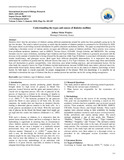| dc.description.abstract | Statistics show that the prevalence of diabetes among different populations around the globe has been gradually going up in the last few decades. The trend is indeed worrying, so much that the number of diabetes patients is estimated to hit 36 million by 2030. This paper aimed at providing essential information for public education on diabetes mellitus. The paper accomplished this goal by conducting a literature review of various articles on types and different causes of diabetes mellitus. These articles were sources from prominent academic databases such as EBSCO, Science Direct, CINAHL, Google Scholar, and MEDLINE. The existing literature cite two types of diabetes, including Type I diabetes and Type II diabetes. Type I diabetes is generally associated with the decrease in the amount of insulin that is being released by the pancreas while Type II diabetes is associated with insulin resistance, insulin insufficiency, and glucagon excess. Both types have different detectable abnormalities. It is imperative that people understand the condition in general and the different factors that cause it. For Type I diabetes, the causes range from autoimmune beta cell destruction to genetic susceptibility, virus infections, poor infant-feeding practices, and environmental factors. On the other hand, the causative factors for Type II diabetes include hypertension, increase in BMI (body mass index), physical inactivity, unfavorable blood lipids, dietary habits, and genetics. To increase the survival rate in the context of diabetes, knowledge of these factors for both types is crucial especially for proper management of the disease. With this knowledge, it is possible for an individual to determine the type of diabetes that they or another person has and that can be life-saving during emergencies. | en_US |

